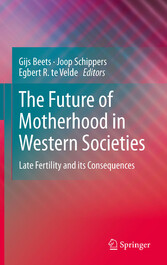Suchen und Finden
Preface
4
Contents
7
Contributors
9
1 Introduction
11
References
14
2 Is Womens Emancipation Still Compatible with Motherhood in Western Societies
15
The Long Past of Motherhood
15
The Contraceptive Revolution
16
Consequences of the Contraceptive Revolution
17
Reproduction without Sex
19
The Differences between Men and Women
20
Emancipation Policies
22
References
24
3 Males and Females: The Big Little Difference
26
Everything Turns around Reproduction
27
Why the Sexes Differ
27
The Little Difference with the Great Consequences
28
On the Polygamy Track or on the Careful Father Track
30
Our Animal Relatives
31
Competing Macho Males
31
When Male Contest does not make Sense
32
Relaxed Relationships between Males
32
Comparing the Hominoids
34
Does the Human Species Fit in This Picture
34
Care Giving Fathers
36
References
39
4 Sexual Differentiation of the Human Brain and Male/Female Behaviour
41
Organization and Activation of the Human Brain
41
Sex Hormones and Brain Development
42
Transsexuality
43
Sexual Orientation: Heterosexuality, Homosexuality and Bisexuality
44
Societys Response to My Research into the Sexual Differentiation of the Brain
46
Sex Differences in Cognition and Aggression: Little Effect of the Social Environment
48
Conclusions
51
References
52
5 On the Societal Impact of Modern Contraception
56
The Mastering of Childbirth
56
The Perfection of Contraception
57
The Development of the Pill
58
Intentions of the Protagonists
58
The Demographic Consequences as Foreseen
59
Consequences for Contraceptive Practices and Legislation
59
Unforeseen Demographic Consequences
60
Effect on Sexual Relations and Marriage
62
Paradoxical Effects
63
By Way of Conclusion
65
References
66
6 The Demography of the Age at First Birth: The Close Relationship between Having Children and Postponement
68
Introduction
68
The Demography of Late Parenthood: Circumstances and Consequences
71
Having the First Child Later than in Previous Generations
71
Postponement and the Increased Risk of Childlessness
74
The Relation Between Age at First Birth and Family Size
76
Will Fertility Behaviour Change in the Future?
78
The Wish for Children
80
The Road Towards Childlessness
82
The Optimal Timing of Parenthood
83
The Limits to Late Parenthood
84
The Age at First Birth among Immigrants
84
Population Growth and Population Ageing
85
Late Parenthood: Non-Demographic Consequences
85
The Determinants of Late Parenthood
86
Partner Selection and Fertility Control
86
Women's Education is a Powerful Determinant of Late Motherhood
87
Normative Pressures, Gender Equality and Uncertainty
89
To Sum Up
90
Conclusion and Discussion
91
Annex 1: Mean Age at First Birth, Selected Countries, Selected Years and in Birth Cohort 1965
93
Annex 2: Fertility Rates, Independent of Birth Order (i.e. Sensitive for Changing Family Size): Percentage Distribution per Age Group of the Mother
94
References
95
7 The Economic Rationality of Late Parenthood
98
Introduction
98
More and More Women Participate, but Parttime Is the Watchword
100
Economics of the Family
105
The Rationality of Late Parenthood
106
The Government: Mothers Little Helper
109
References
111
8 The Complexity of Parenthood in Modern Societies
113
Introduction
113
Various Types of European Welfare Regimes
114
The Social Democratic Welfare State Regime
114
The Conservative Corporatist Welfare State Regime
115
Mediterranean Regime
115
The Liberal Welfare State Regime
116
Post-communist Welfare State Regime
116
To Conclude
117
Fertility Rates and the Division of Paid and Domestic Work between Women and Men in European Countries
118
Cultural Meanings of Motherhood
121
De-standardization and the Notion of Individualistic Motherhood
122
Motherhood as a More or Less Joint Collaboration with the Partner
123
The Context of Childbearing Choices
124
Designing Motherhood and Parenthood in Modern Europe
125
Some Concluding Remarks
127
References
128
9 The Importance of Children and Families in Welfare States
131
Introduction
131
Fertility
132
Explaining the Child Gap
134
The Quality of Children
137
Explaining Inequalities in Child Outcomes
138
Redesigning the Welfare State: A Social Investment Approach
140
Public Policy and Fertility
141
Public Policy and Children's Life Chances
142
Designing a Childcare System
145
Conclusions
150
References
152
10 The Post-career Mom: Reproductive Technology and the Promise of Reproductive Choice
155
Introduction
155
Prologue: From Baby Boom to Fertility Decline
155
An Anniversary: The Pill Turns 50
155
Reproductive Freedom Revisited
156
Trends in Medical Technology: From the Pill to Reproductive Medicine and Prenatal Diagnosis
157
Postponement
157
The Pill as First Step in Reproductive Technology
158
The Risks of Late Motherhood
158
Summing Up
159
Prospects for the Future: Late, Later, Latest
159
First Scenario: The Political Option
160
Second Scenario: The Technological Option
161
Conclusions
162
References
162
11 On Delayed Fatherhood: The Social and Subjective "Logics" at Work in Men's Lives (a UK Study)
164
Perpetual Postponers
164
Our Analytical Approach
167
Commitment and Responsibility
168
A Life of Ones Own
170
The Unknown
171
The Childs Best Interests
173
The Changing Role of Fathers
174
Conclusions
175
References
177
12 Womens Lifestyle Preferences in the 21st Century: Implications for Family Policy
181
Introduction
181
Preference Theory
183
Feminist Debates
189
Policy Implications of Female Diversity
190
Conclusions
194
References
196
13 The Future of Motherhood: Conclusions and Discussion
200
Conclusions
200
Discussion
203
Emancipation and Gender Equality
203
The Consequences for Motherhood
205
Towards a New Policy Approach of Motherhood
206
A Common Nordic Fertility Regime
209
Illusion or Goal within Reach?
209
The Future Timing of the First Child
210
References
211
Author Index
213
Subject Index
218
Alle Preise verstehen sich inklusive der gesetzlichen MwSt.




















